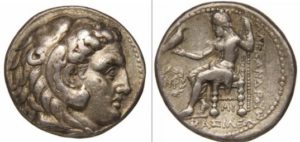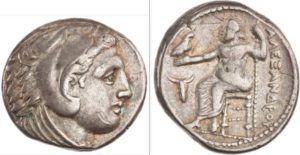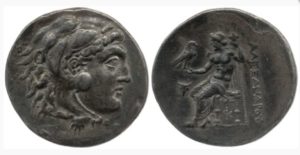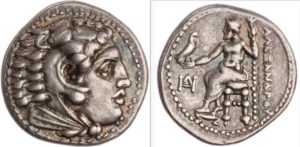Ecco l’ennesimo caso di un “professionista non professionale” nel mondo del commercio numismatico. Ho appena dato uno sguardo all’asta online 68 del 2 ottobre della casa d’aste WAG online Auktionen oHG.
This is yet another case of a “professional unprofessional” in the world of numismatic trade. I’ve just taken a look at online auction 68, October 2, of WAG online Auktionen oHG.
https://www.sixbid.com/browse.html?auction=2998 .
Ho visionato 3 sole monete, quelle di mio maggiore interesse. Poi mi sono fermato. Si tratta dei lotti 1, 2 e 4: due tetradrammi di Alessandro Magno e uno di Atene. Non sono un “professionista professionale” del settore e quindi non voglio discutere della genuinità dei pezzi, ma piuttosto soffermarmi su altri aspetti più consoni al mio background di tipo accademico:
1- di nessuno dei tre esemplari è indicato il riferimento bibliografico, cosa che dovrebbe essere la prassi per un professionista. Il che ci porta a…
2- non hanno indicato il riferimento bibliografico, perchè evidentemente non lo conoscono. Ciò è accettabile per un “professionista non professionale”, ma non per uno “professionale”.
I watched only 3 coins, those of my interest. Then I stopped. It is lots 1, 2 and 4: 2 Alexander’s and 1 Athens’s tetradrachms. I’m not a “professional professional” and so I will not discuss the authenticity of the specimens, but I’ll rather focus on other aspects more suitable for my academic background:
1- none of the three specimens has a bibliographic reference, which should be normal for a professional. This fact led us to …
2- they didn’t indicate the bibliographic reference, obviously because they didn’t know it. This is acceptable for a “professional unprofessional”, but not for a “professional professional”.
Lot n°1: https://www.sixbid.com/browse.html?auction=2998&category=61802&lot=2497457
E’ definito come tetradrammo di Mileto, evidentemente per la presenza delle lettere MI sotto il trono di Zeus. Ciò è imbarazzante: secondo me infatti la zecca di MI-lano è più probabile… a parte le battute, la tipologia è in realtà Price 3746, attribuita alla zecca di Babilonia (311-305 a.C.). Vediamo un esemplare analogo del Münzkabinett di Berlino:
It‘s indicated as Miletus tetradrachm, evidently due to the presence of MI under the throne of Zeus. This is embarrassing: in fact I think the mint of MI-lan is more likely … but, joking aside, the type is actually Price 3746, attributed to the mint of Babylon (311-305 BC). We see a similar coin from Berlin Münzkabinett:

Im. 1: Price 3746 from Münzkabinett (http://ww2.smb.museum/ikmk/object.php?id=18207742&size=0&content=0&side=0).
Lot n°2: https://www.sixbid.com/browse.html?auction=2998&category=61802&lot=2497458
E’ definito come tetradrammo di Parium (almeno hanno avuto il buon senso di mettere un bel ?), evidentemente per la presenza del bucranio in campo sinistro del rovescio come nei tipi Price 1459-60 attribuiti alla zecca di Parium (280-75 a.C.). Da notare in questi casi (tra l’altro) la presenza di monogrammi sotto il trono di Zeus. La tipologia è invece quella del Price 93, attribuita alla zecca di Anfipoli (336-323 a.C.). Vediamo prima un esemplare analogo e addirittura con gli stessi conii di dritto e rovescio dalla collezione dell’ANS:
It‘s indicated as Parium tetradrachm (they had at least the good sense to use ?), apparently due to the presence of bucranium in left field on the reverse as in the types Price 1459-60 attributed to the mint of Parium (280-75 BC). Let’s watch in these cases the presence of monograms under the throne of Zeus. The type is instead that of Price 93, attributed to the mint of Amphipolis (336-323 BC). Let’s see a similar coin and even with the same obverse and reverse dies from the ANS collection:

Im. 2: Price 93 from the ANS collection (http://numismatics.org/collection/1944.100.27692).
E poi i due tetradrammi attribuiti alla zecca di Parium col simbolo del bucranio:
Then 2 tetradrachms attributed to the mint of Parium with the bucranium symbol:

Im. 3: Price 1460 from British Museum (http://collection.britishmuseum.org/resource?uri=http://collection.britishmuseum.org/id/object/CGR40422).

Im. 4: monogramma sotto il trono di Price 1459, del quale non sono riuscito a reperire un’immagine. Monogram under the throne in Price 1459, of which I did’t find a picture.
Mi chiedo se il testo del Price non lo possiedano o, pur non pretendendo che lo conoscano a memoria, le tengano su uno scaffale a prendere polvere? Avendolo utilizzato qualche volta, in presenza di simboli o lettere riconoscibili, ci vogliono 2 minuti per identificare correttamente una moneta all’interno del catalogo…
I wonder if they don’t possess the book of Price or, not pretending that they know it inside out, they leave it on a shelf gathering dust? Having used it a few times, in the presence of recognizable symbols or letters, it takes 2 minutes to correctly identify a coin in the catalogue…
Lot n°4: https://www.sixbid.com/browse.html?auction=2998&category=61802&lot=2497460
E’ definito correttamente come tetradrammo di Atene, ma, visto che si tratta forse della più famosa moneta dell’antichità, sarebbe davvero difficile un’errata identificazione. Hanno dato, bontà loro, persino una datazione (479-393 a.C.), ma forse avrebbero fatto più bella figura non segnalandola. Infatti esistono vari studi (il testo del Flament che è davvero molto specialistico, ma anche quello del Kroll) nei quali le monete di Atene vengono ordinate cronologicamente in differenti gruppi all’interno del periodo greco classico. Qui l’hanno indicato tutto… e pure scorrettamente perchè la coniazione dei tetradrammi in argento ad Atene si interruppe dal 406/5 al 393/2 a.C….1 E’ come se una moneta imperiale romana venisse datata 27 a.C.-476 d.C.. Bisogna però dire che a differenza dei due casi precedenti, viste le numerose varianti distinte in base a particolari minimi, un’identificazione precisa è molto più complessa e magari, per un non specializzato in monetazione ateniese, richiederebbe un’oretta buona… ma non è forse per questo che si acquistano monete da professionisti?
It‘s correctly indicated as Athens tetradrachm, but since it is perhaps the most famous coin of antiquity, it would be really hard to misidentificate. They gave, it’s amazing, even a dating (479-393 BC), but perhaps they would have done more good impression not giving it. In fact there are several studies (the text of Flament which is really very specialized, but also that of Kroll) in which Athenian coins are arranged chronologically into different groups within the classic greek period. Here they indicated everything … and also incorrectly because the minting of silver tetradrachms in Athens broke off from 406/5 to 393/2 BC 1 … It ‘s like a Roman imperial coin dated 27 BC-476 AD. But we must say that, unlike the two previous cases, given the many different variants based on the smallest details, a precise identification is much more complex and maybe, for a non-specialist in the Athenian coinage, would require an hour or something like that... Is that not what you buy coins from professionals?
Come si spiega una situazione del genere? Il commerciante si adegua in questo, come altri casi, al collezionista medio che, senza che io ritenga ciò una colpa da parte sua, non ha spesso interesse per questi aspetti: gli basta avere in mano una moneta esteticamente gradevole e autenticata da un sedicente professionista. Ma come fa quest’ultimo a essere certo che sia genuina se non ha la benchè minima conoscenza della moneta che sta vendendo?
How do you explain such a situation? The market is adapting in this, as other cases, to the average collector who, not considering this as a fault of his own, often has no interest in these aspects: they just want a coin aesthetically pleasing and authenticated by an alleged professional. But how can they be sure it’s genuine if they don’t know the coin that are selling?
ADDENDA
Dalla Subasta 93 – Mail auction di MARTÍ HERVERA S.L del 18 ottobre 2016:
From Subasta 93 – Mail auction, October 18, of MARTÍ HERVERA S.L.:
https://www.sixbid.com/browse.html?auction=3022&category=62417&lot=2518743
Questa dramma di Alessandro Magno è definita di “ceca incierta” (zecca incerta), dato che l’indicazione bibliografica utilizzata è quella ottocentesca del Müller (763). In realtà si tratta di un tipo particolarmente comune: Price 2090, attribuito alla zecca di Mileto (325-3 a.C.). Un piccolo aggiornamento non farebbe male…
This drachm of Alexander the Great is defined of “ceca incierta” (uncertain mint), since the used bibliographic indication is that the nineteenth-century text of Müller (763). Actually is a very common type: Price 2090, attributed to the mint of Miletus (325-3 BC). A little updating would not hurt …
http://numismatics.org/pella/id/price.2090?lang=it

Im. 5: Price 2090 from the ANS collection (http://numismatics.org/collection/1944.100.31849).
1:Flament 2007, pp. 118-122.
BIBLIOGRAPHY:
C. Flament, Le monnayage en argent d’Athènes. De l’époque archaïque à l’époque hellénistique (c. 550-c. 40 av. J.-C.), Louvain-la-Neuve, 2007.
J.H. Kroll, The Greek Coins. The Athenian Agora, vol. XXVI, Princeton, 1993.
L. Müller, Numismatique d’Alexandre le Grand; Appendice les monnaies de Philippe II et III, et Lysimaque, Copenhagen, 1855-58.
M.J. Price, The Coinage in the Name of Alexander the Great and Philip Arrhidaeus, 2 voll., London, 1991.
Ciao Davide.
“Ecco l’ennesimo caso di un “professionista non professionale” nel mondo del commercio numismatico”.
La Tua “denuncia” è certamente fondata, anche se, a onor del vero, esistono e operano sul mercato anche eccellenti professionisti e dunque non sarebbe corretto fare di tutte le erbe un unico fascio.
Piuttosto, la Tua denuncia pone un interrogativo e cioè: com’è possibile che in un mercato molto competitivo e globalizzato come quello numismatico possano ancora sopravvivere operatori “trascurati” che non si curano di aspetti della vendita che sono tutt’altro che secondari?
La mia risposta a questa domanda è che ciò accade in quanto “il consumatore” di questi servizi carenti e/o approssimativi è un soggetto altrettanto carente e/o approssimativo, il quale è unicamente interessato a “fare un affare” (e chissà se poi lo farà davvero…) ma è assolutamente incapace di valutare il valore aggiunto che un bravo commerciante sa infondere ad una vendita numismatica.
Al più, tale consumatore si lamenterà se la poca professionalità del commerciante andrà a rovinare il suo “orticello” perchè altrimenti, se costui non è coinvolto direttamente, qualunque lamentela che verrà segnalata non lo toccherà più di tanto.
L’importante è che egli non sia “la vittima”. Tutto il resto lascia il tempo che trova.
D’altronde, se così non fosse non si capirebbe come taluni operatori continuino a stare sul mercato nonostante plateali sviste o “incidenti”, che in altri settori economici porterebbero come minimo ad uno “sputtanamento” commerciale dell’operatore ma che nel nostro ambiente passano quasi sotto silenzio e comunque, anche quando sortiscono qualche considerazione, vengono dimenticati quasi subito, forse perchè ….”the show must go on…”.
Quindi, per quello che è il mio modestissimo osservatorio del settore, ripartirei quanto meno al 50% tra venditori ed acquirenti la responsabilità di certa sciatteria commerciale, che a quanto pare è destinata a perpetuarsi fino a quando certa clientela troverà normale tale sciatteria da parte di alcuni operatori.
Saluti.
Michele
Ciao Michele,
su questo argomento non voglio certamente fare di tutta l’erba un fascio, a differenza di quello etico… Sono d’accordo con te che ci siano anche molti commercianti di notevole caratura “accademico numismatica”, ma i casi di impreparazione sono altrettanto diffusi. Un commerciante, se vuole essere un professionista e non un monetivendolo deve non solo saper dire:”Mi sembra vera/falsa”, ma poiché ciò si lega direttamente all’affermazione precedente, deve conoscere (lui o un suo incaricato) a menadito la monetazione che sta vendendo. Ciò, assieme a una preparazione tecnica, e’ il plusvalore che un professionista deve avere. Non mancano casi, molti in realtà, anche da parte di venditori scientificamente di alto livello che hanno grossi svarioni probabilmente per la fretta di compilare un catalogo (ergo non consultano le fonti primarie, ma si servono di altre secondarie e cioè internet). E come disse un noto commerciante:”Solo il papa non sbaglia, ma la superficialità non è accettabile”. Continua…
Una delle mie monetazioni preferite e’ quella di Patrao di Peonia, per cui mi sono acquistato a caro prezzo il quasi introvabile catalogo Sotheby’s del Paeonian Hoard (IGCH 410) del 1969, che è il testo fondamentale sull’argomento. Presso una rinomata e di alto livello casa d’aste tedesca ne ho trovato in vendita un esemplare splendido (poi andato a 1.500€ mi pare). Veniva dato come esemplare, con tanto di numero di catalogo, proveniente da quell’hoard. Apro il mio volume, che quasi nessuno ha, e la moneta ha si gli stessi conii, ma non è certamente la stessa. Devo dire che dopo la segnalazione hanno immediatamente cambiato la descrizione del pezzo… Ma quell’errore era un enorme plusvalore. Continua…
Sull’ultima questione sono parzialmente d’accordo con te. Senza dubbio le cause di questa “sciatteria” numismatica come ho scritto nell’articolo sono da distribuirsi tra venditori e acquirenti, ma bisogna fare un grosso distinguo.
Mi si rompe la macchina e vado dal professionista meccanico. Io non so nulla di meccanica e mi affido completamente a lui. Poi scopro che mi aveva rattoppato la macchina facendomi pagare un prezzo spropositato… Ho forse qualche colpa? Ha forse qualche colpa uno che non sa niente di numismatica, ma si compra qualche o a volte molte monete solo perché luccicano e si fida del commerciante di turno? Fare il collezionista non è un lavoro, ma un hobby che può essere intrapreso in maniera più o meno approfondita. Fare il numismatico e’ un lavoro e in quanto tale deve essere fatto con la massima professionalità indipendentemente dall’ignoranza in materia della gente. Quest’ultima, ben lungi dall’essere una scusante per certi comportamenti pressapochistici (non di tutti ovviamente, ma molto diffusi), e’ a mio modo di vedere una maestosa aggravante. “Chissenefrega se catalogo male una moneta, tanto quelli ne sanno meno di me e comunque non gli interessa…” Questo è l’atteggiamento che più volte ho riscontrato: Svilimento della professionalità di fronte a una clientela non preparata. Ma cosa cambia che facciano le cose bene o male? Semplice: Il tempo è denaro e coi tempi ristretti coi quali si è COSTRETTI a preparare nuove aste le cose bene e’ difficile farle. Ma non è forse per questo che ci si rivolge a professionisti?
“Mi si rompe la macchina e vado dal professionista meccanico. Io non so nulla di meccanica e mi affido completamente a lui. Poi scopro che mi aveva rattoppato la macchina facendomi pagare un prezzo spropositato”
Non so quanto il Tuo paragone sia calzante in questo caso.
L’uso della macchina è una necessità e quando essa si rompe si è obbligati a farla aggiustare perchè se ne ha bisogno.
Al contrario, collezionare monete è un hobby che, per quanto ne so, si coltiva innanzitutto studiando ciò che poi si acquisterà.
O vogliamo pensare che esista qualcuno che, completamente digiuno di numismatica, oggi si sveglia è decide di comprare una moneta di Patrao di Peonia in un’asta internazionale?
Non credo.
Se lo fa, mi aspetterei che costui abbia almeno un’infarinatura di quella monetazione e sappia, almeno, che cosa sta comprando.
Altrimenti dovremmo ipotizzare che un collezionista che acquista monete (fra l’altro di monetazioni spesso “difficili”) in un’ asta internazionale, sia un soggetto totalmente inconsapevole di ciò che sta facendo.
Mi sembra poco credibile, salvo pensare a soggetti affetti da patologie psichiatrico-compulsive.
E allora, torno a dire, considerando che l’acquisto di una moneta non ha la stessa impellenza e necessità che riveste il portare la macchina dal meccanico per una riparazione, fino a quando esisteranno acquirenti che non faranno differenza fra l’operatore sciatto e quello professionale (e ciò anche solo perchè l’operatore sciatto è comunque in grado di proporre monete di loro interesse, anche se mal presentate), questi operatori sciatti continueranno a stare sul mercato.
Teniamo anche conto del fatto che un operatore sciatto può sbagliare la catalogazione di una moneta anche a suo svantaggio e ciò è motivo di grande soddisfazione per il collezionista che si avvantaggia di tale errore.
Quindi, ribadisco che, nel gioco delle parti, le responsabilità di certa sciatteria la ripartisco equamente tra operatori e acquirenti.
M.
Responsabilità forse, ma l’acquirente non ha colpa… d’altro canto il commerciante sciatto si approfitta dell’ignoranza altrui. Quanto al Patrao sono certo che anche nessuno dei luminari del forum se ne sarebbe accorto, a meno di non possedere quel raro testo. E i testi di numismatica sono spesso molto rari…
Comunque non vedo perché qualcuno non potrebbe comprare un Patrao, non avendo la minima idea di chi fosse, solo perché gli piace il cavaliere che infilza il fante. Ne ho vista di gente con collezioni sulle quali ho versato non poca bava non sapere cosa avesse in mano… “Cos’è Price???” E lì era Alessandro e non Patrao… Ce ne sono molti così, soprattutto anziani, che comprano monete solo perché gli piacciono. Gli unici che possono trarre vantaggio dai commercianti sciatti sono quelli che ne sanno, non certo il vecchietto che acquista una gradevole e luccicante moneta…
“Ce ne sono molti così, soprattutto anziani, che comprano monete solo perché gli piacciono”
Mah, se le cose stanno così e cioè se c’è in giro gente che compra monete antiche senza avere la minima consapevolezza di ciò che sta acquistando ma solo perchè una moneta li attira perchè “brilla”, devo concludere che il mio modo di intendere il collezionismo numismatico e mille miglia distante da costoro.
Un conto può essere turlupinare gli acquirenti con monete moderne, che le zecche infiorano con astucci accattivanti e che nascono proprio con l’unica finalità di rappresentare un “gadget”, che con la numismatica ha ben poco a che fare.
Te li propongono anche nelle televendite, come si farebbe per un set di pentole o per un materasso, ed è normale che un “consumatore” (non mi va neppure di chiamarlo collezionista) possa abboccare alla suadente offerta, senza neanche sapere che cosa sta in realtà acquistando.
Ma che ciò possa avvenire anche con le monete antiche, francamente mi lascia di stucco.
Ad ogni modo, vuoi per la dabbenaggine di chi non sa cosa sta comprando e acquista una moneta solo perchè “luccica” o vuoi perchè ci sono in giro gli “squaletti”, che dall’ignoranza e sciatteria dell’operatore talvolta ci guadagnano, il discorso rimane sempre quello: la sciatteria commerciale di alcuni operatori sarà sempre direttamente proporzionale all’ignoranza o alla furbizia dei loro clienti.
M.
Concordo in toto con quest’ultima affermazione. Fare il meno possibile/ non più del necessario, adattarsi in peggio alle carenze altrui (“tanto se faccio una cosa bene nessuno se ne accorge”) sono tristemente elementi intrinseci della natura umana. Non ho la pretesa di cambiare nulla, ma, data la mia natura polemica, mi limito a denunciare comportamenti che ritengo scorretti in un ambito che mi sta molto a cuore. Ma in fondo si tratta solo di “continue lamentele” potenzialmente turbanti la serenità di una persona interessata ad acquistare monete senza porsi troppi problemi…